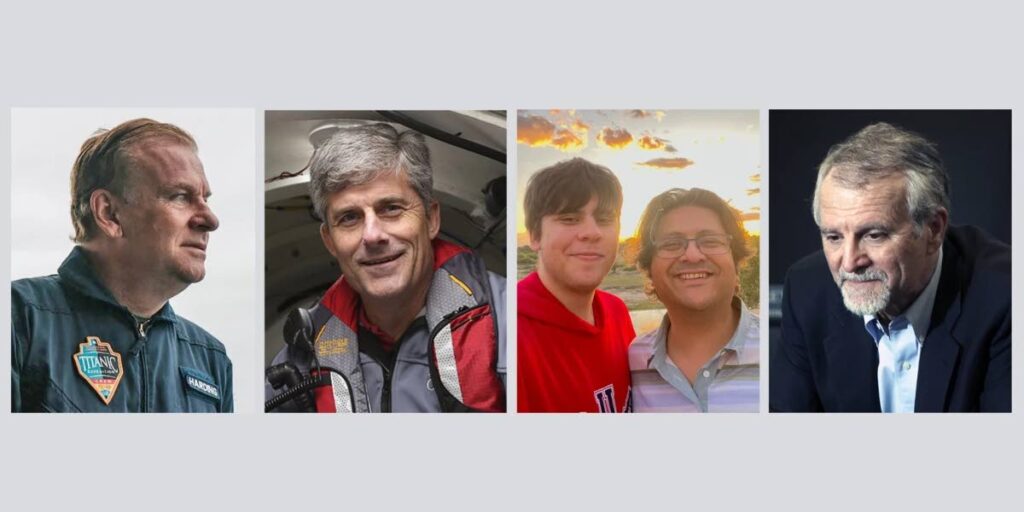The risk-takers

When this column started, news had not yet come of the death of five men in a tiny submarine – submersible – some 12,500 feet under the sea, about 400 miles off the coast of Newfoundland. Everyone hoped they would be found alive, either bobbing upon the sea’s surface somewhere in the 20-mile radius of the search-and-rescue mission or sitting quietly on the ocean floor waiting to be rescued before their oxygen supply expired.
The US-led hunt for the missing tourist submarine was one of the biggest in recent times – commercial and private ships from several countries, two French and Canadian ones outfitted with unique robots capable of reaching down the necessary 12,500 feet and lifting the submersible were just two of the dozen or so search-and-rescue vessels deployed, which included helicopters, planes and submarines.
The submersible, Titan, went missing while descending to the wreck of the famous Titanic, the largest luxury ship of its time, which sank on its maiden voyage to New York in 1912, losing 1,500 of 2,200 people on board and becoming a fascination for many over the last century. This disaster, so close to the very wreck of the Titanic, will cast a new spell upon some and probably make this remote marine location the focus of some very wild imaginings.
The submersible was the size of a truck, able to take just five people sitting on the floor in a small, narrow space measuring just 22 by 9.2 by 8.3 feet, hardly able to move around. It was designed with state-of-the-art technology that enabled a variety of data collection and deep-sea testing of hardware and software, but it also took tourists down to see the Titanic wreck via the super-cameras and other equipment externally fitted.
It sounds interesting enough, but no joyride. It would take a very special person to pay US$250,000 for the enormous risk of being bolted in for eight hours into an uncomfortable capsule that cannot be opened from the inside, has one externally sealed portal, possesses only one button, is run using a video-game controller and goes down so deep into the sea that no divers or any regular submarine rescue vehicle can reach it, and with no possible GPS and radio communications.
In the end, it seems the capsule imploded just 1.45 hours into the adventure.
When I first heard that a billionaire English businessman was one of the five, I immediately guessed it was Richard Branson, the eminent founder of the Virgin empire, who is well known for his high-risk business and personal exploits, such as being the first billionaire to go into space and investing heavily in space travel.

I should have worked out that Branson tends to go high, not deep. The Englishman involved in the Titan disaster was another billionaire adventurer who did both.
Hamish Harding flew in space last year on a private flight and apparently held three Guinness world records, including for the longest time spent at full ocean depth during a dive to the deepest part of the Mariana Trench, and also made several trips to the South Pole – an extreme adventurer, no doubt.
He was accompanied on the Titan exploit by the multi-millionaire Pakistani businessman Shahzada Dawood, an explorer of “different natural habitats”; French ex-navy Titanic expert Paul-Henry Nargeolet, who was a professional risk-taker; and Stockton Rush, chief executive of OceanGate, who went on every Titan dive. Dawood’s teenage son was along for the experience. Sadly, he started his journey of discovery at an extreme point.
Both Harding and Branson, in interviews, insisted on being seen as risk-takers but not reckless ones. They calculate the risk in arriving at the desired outcome, not like a teenager who plunges into the unknown without doing the necessary homework and then learns that the result could be devastating or even fatal. Adults are more focused on the result and the consequence, generally, while young people often take risks to be popular.
I once knew a beautiful young man, the pride of his family and always at the centre of events, who need not have risked diving into the Mediterranean off a rock in a place he did not know just to show bravado. He broke his neck and many hearts.
It seems some of us are more prone to extreme risk-taking, such as Formula One (F1) car racing drivers. I read online that a gene, the DRD4, has been found to “regulate hormone levels in the reward centre” of our brains, and if you carry the long version of the gene, you are likely to take 25 per cent more risk than other people.
As if to prove Branson’s point, F1 racing, for instance, is so regulated that it is safer than it looks, and when its great star, Michael Schumacher, having retired from F1, sought the thrill of travelling at great speed and skied off piste, he ended up cracking his head on an Alpine rock and has been in a coma ever since. He obviously had a huge appetite for risk that had to be satisfied somehow.
It seems that if you are prone to taking risks you will always indulge.


Comments
"The risk-takers"